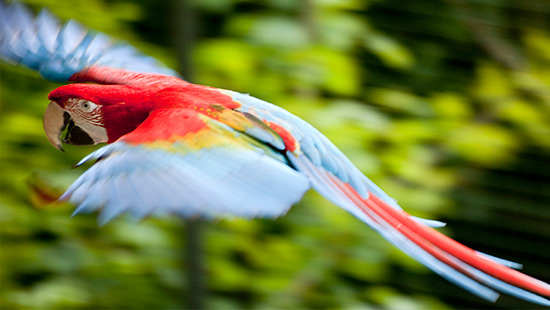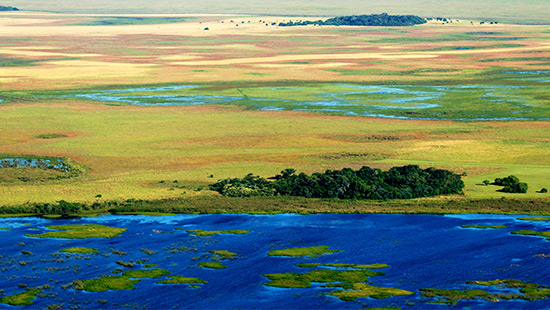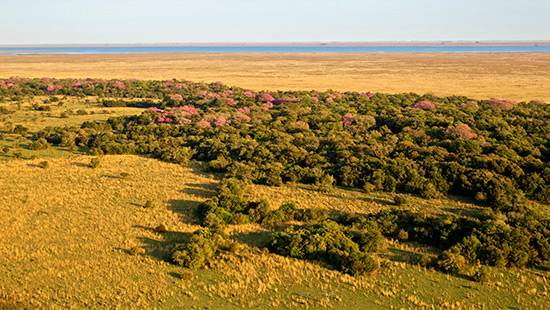Green-Winged Macaw
Our goal is to create a self-sustaining green-winged macaw population to inhabit the Ibera Nature Reserve and its surrounding forests.
Current status of the project (updated to February 2019): After several months of training, including flight exercises, recognition of predators and feeding with native fruits, between nine and eleven macaws live totally free in the Cambyretá reserve. Some of them have already flown more than 75 km from the releasing site, arriving near neighboring towns where people have enjoyed their presence and received them with great joy. Five other animals are already being trained in a large flight cage, and are expected to have a gradual release in the coming months. Other macaws are going through a quarantine phase before being transferred to the reserve to begin their training.
Macaws: historical inhabitants of Ibera
Due to their colourful plumage, macaws have been persecuted by humans since ancient times. At least two species of these large birds inhabited Corrientes: the glaucus macaw (Anodorhynchus glaucus) or "guaá-hovy '', which became extinct worldwide and the green-winged macaw (Ara chloropterus) or “guaá-pytá” which disappeared not only from the province of Corrientes but also from the rest of Argentina.
Macaws inhabited the fields with patches of jungle, palm groves and gallery forests in Corrientes and in other provinces such as Formosa, Chaco, Santa Fe, Misiones and Entre Rios. Nowadays, the populations of green-winged macaw closest to Corrientes are found at more than 300 kilometers to the north in the states of Mato Grosso do Sul and Parana in Brazil, in the northern end of Paraguay, and in southeastern Bolivia, where they are not adequately protected.
Globally, the green-winged macaw is listed on the IUCN Red List as a species of "least concern". In Argentina it is formally classified as "critically endangered", although there are no recent records and it is actually considered extinct.

Historical records showing the existence and subsequent disappearance of the green-winged macaw in Northern Argentina
Some of the few mentions about green-winged macaw in our country are those by Alcides D'Orbigny (1945), who in 1847 captured one in his travels to Corrientes, more precisely while sailing the Parana River around the Ita Ibaté area. Previously, Felix de Azara (1809) reported that between 1781 and 1801 the species could be found around the city of Asuncion and throughout southern Paraguay in Ñeembucú, mentioning northern Argentina, up to 28 degrees latitude, as its distribution range. Sanchez Labrador also mentions its presence in southern Paraguay.
In 1881, Commander Fontana registers it in the Chaco province, as does Enrique Lynch Arribalzaga in his 1920 "Birds of Chaco" publication. However, in 1895, Eduardo Holmberg also remarks "it is brought from Paraguay in large numbers; I remember seeing it in Chaco, but Gonzalez brought two from the Pilcomayo ". In June 1891, Bertoni (1901) commented about the capture of one in the high Paraná as follows: "I killed it when it was eating fruits of Esenbeckia Guatambu, with three other same sized individuals (...) this species is often seen crossing the Parana river, it looks as if it sleeps on the Argentine coast and crosses every day to eat on the Paraguayan coast ". The latter observation corresponds to a point on the Argentine coast in the northwest of Misiones. There are also records from 1883 for Santa Ana, department of Candelaria, Province of Misiones, up until1917 when perhaps one of the last wild individuals in Argentina was hunted in the province of Formosa (Chebez 2008).
These historical accounts illustrate how well the macaw lived in the forests of the region. Many species of trees such as the mbocaya timbó and palm trees, among others are mentioned as feeding or nesting trees for the macaw. However it is also remarkable that most naturalists comment on how the bird was used for food, pets or offerings. It is easy to understand why this species underwent extinction when combining this to the coincidental rise of human settlement in the region between Asuncion and Corrientes, as well as the increase in cattle activity that developed in the 1700s and 1800s. To get an idea of the impact of human activities in the northwestern region of Corrientes it is worth considering that the cattle density at that time was roughly equivalent to the one found today in the province. To add to this negative impact, wars and gerrillas that devastated the northern region of Corrientes during all those years must also be mentioned.
The opportunity to recover a “great one"
Ibera Natural Reserve represents an almost unique opportunity to recover the presence of this real "jewel of the air" in Argentina. The reserve currently has a large protected area of adequate habitat with enough forest patches to house a stable population of green-winged macaw both in the public Provincial Park as in the privately owned reserves. Additionally, the Ibera has institutions and experts with experience in the restoration of extinct and endangered populations such as the Giant Anteater, the pampas deer and collared peccary.

Four reasons to recover the green-winged macaw
- It plays a key role in the functioning of the forests patches due to control and dispersion of the fruits and larger sized seeds of the indigenous trees.
- It means the recovery of a species extinct in Argentina as well as the conservation of a wild population at the southern end of the global geographic distribution of the species.
- It represents a first class tourist attraction since it is considered one of the most spectacular birds of America, hence, contributing to the development of local communities.
- Also, helps regain the cultural value for the people of Corrientes since the macaw is present in artistic expressions and historical accounts.
From captivity to freedom in Ibera
This project obtains green-winged macaws from different zoos and breeding centres around the country. These animals are taken to the Aguará Ecological Facility in the province of Corrientes, where groups of individuals are consolidated and where all necessary health checks are done in order to rule out diseases that could be spread in the wild after release.
Before transfer to the release site a small radio transmitter is fitted onto the birds to aid in the tracking of each individual once released into the wild. Prior to release these birds spend several weeks in an acclimation aviary in the Cambyretá area, south of Ituzaingó and of Villa Olivari, in the north portal access to the Ibera Wetlands. In this aviary animals learn to feed on native fruits and they acquire other skills necessary for their reintegration to nature. After release and as they expand their area of action, the macaws are monitored by project staff to check if they adapt to the natural environment, reproduce and their long-term survival.

The return of the green-winged macaw is the result of collaboration of multiple institutions
CLT funds most of the project thanks to the donation of a European philanthropist and brings expertise in wildlife reintroduction projects in Ibera. CONICET scientists contribute their knowledge on the ecology of these birds and on their reintroduction. The Department of Natural Resources of Corrientes provides the Aguará Center facilities to house the animals before they are transferred to Ibera. The Department of Parks and Reserves authorises and supervises its proper implementation on the ground. Several ecological parks, rehabilitation wildlife centres and zoos across the country provide the animals to be released. Finally, several groups of volunteers, including scouts, schools and birdwatchers collaborate in spreading the project and contribute with their observations of animals in the field.

